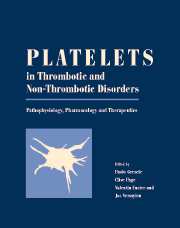Book contents
- Frontmatter
- Contents
- List of contributors
- Editors' preface
- PART I PHYSIOLOGY
- PART II METHODOLOGY
- PART III PATHOLOGY
- PART IV PHARMOLOGY
- 61 Aspirin
- 62 Pharmacology of ticlopidine and clopidogrel
- 63 Platelet membrane glycoprotein (GP) IIb–IIIa antagonists and acute arterial thrombosis
- 64 Other antiplatelet agents
- 65 Pharmacogenetics as a new antiplatelet strategy
- 66 Cardiovascular gene therapy: implications for platelet vessel wall interactions
- 67 Pharmacological modulation of the inflammatory actions of platelets
- PART V THERAPY
- Afterword: Platelets: a personal story
- Index
- Plate section
67 - Pharmacological modulation of the inflammatory actions of platelets
from PART IV - PHARMOLOGY
Published online by Cambridge University Press: 10 May 2010
- Frontmatter
- Contents
- List of contributors
- Editors' preface
- PART I PHYSIOLOGY
- PART II METHODOLOGY
- PART III PATHOLOGY
- PART IV PHARMOLOGY
- 61 Aspirin
- 62 Pharmacology of ticlopidine and clopidogrel
- 63 Platelet membrane glycoprotein (GP) IIb–IIIa antagonists and acute arterial thrombosis
- 64 Other antiplatelet agents
- 65 Pharmacogenetics as a new antiplatelet strategy
- 66 Cardiovascular gene therapy: implications for platelet vessel wall interactions
- 67 Pharmacological modulation of the inflammatory actions of platelets
- PART V THERAPY
- Afterword: Platelets: a personal story
- Index
- Plate section
Summary
Cross-talk between inflammation and coagulation pathways
Blood clotting is a host defence mechanism that, together with inflammatory and repair processes, provides to preserve the integrity of the vascular system. There is much evidence for a cross-talk between inflammation and coagulation coming from both experimental and clinical evidence. In this respect, there is now a tendency to consider an inflammatory event as a prethrombotic status and to look for therapeutic agents that modulate both processes. The endothelium is the first site where the coagulation and inflammatory cascades interact. Under physiological conditions, vascular endothelium prevents coagulation and thrombosis by releasing inhibitors of platelet activation and potent vasodilators, such as prostacyclin (PGI2) and nitric oxide, counteracting the effect of procoagulant factors. Endothelial cells also synthesize a number of negatively charged molecules, such as glycoproteins, glycosaminoglycans, chondroitin sulfate and heparan sulfate, which contribute to a non-thrombogenic surface. On the endothelial surface, thrombomodulin (TM), a high affinity receptor for thrombin is also expressed. The complex thrombin–TM activates protein C (PC), a vitamin K dependent glycoprotein that circulates in plasma as zymogen. Once PC is activated, it forms a complex with a vitamin Kdependent cofactor, Protein S (PS) on endothelium. Activated Protein C (APC) plays a major role in regulating the coagulation and fibrinolysis by inactivating factor Va and VIIIa and by inactivating tissue-plasminogen activator inhibitor (t-PAI). Thus, APC inhibits coagulation and stimulates the fibrinolytic pathway.
- Type
- Chapter
- Information
- Platelets in Thrombotic and Non-Thrombotic DisordersPathophysiology, Pharmacology and Therapeutics, pp. 991 - 1000Publisher: Cambridge University PressPrint publication year: 2002



